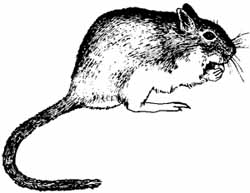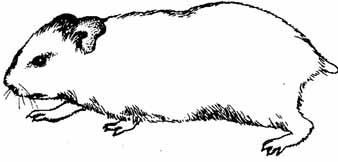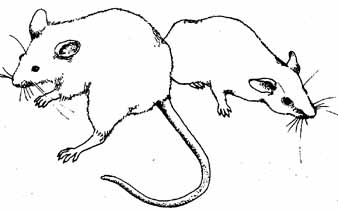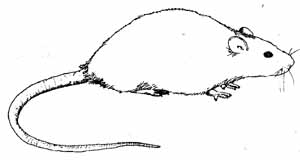Despite the general aversion to their close relatives, there are several rodents, including certain rats and house mice, enjoying a vogue as household pets — and household pets they are, quite literally. Rodents should not be taken outdoors because they are likely to scamper away and get lost. Guinea pigs are an exception to this rule. The most popular rodents at present are gerbils, hamsters, albino mice and rats, and guinea pigs. While having some similarities, each species has its own special merits as a pet.
Gerbils
The Mongolian gerbil (Meriones unguiculatus), the common field mouse of eastern Asia, was first introduced to this country in 1954, to be used in medical research. In little more than a decade, its handsome appearance and gentle personality had won it many fans in the general public. Overall, the gerbil grows to about 8 inches, half of which is sleek, furry tail. An animal this size weighs around ounces.
The gerbil’s back is a rusty brown, with dark guard hairs over a dense gray undercoat. The underside is cream or light gray. The head is broad and proportionately shorter than that of a rat, with long expressive whiskers and large dark eyes. The long tail, small forefeet, and much longer hind legs give the gerbil something of the appearance of a pocket-size kangaroo, especially when it stands up to look around. But its coloring, size, curiosity, and sudden, swift movements are more reminiscent of chipmunks and ground squirrels.
Gerbils are easily tamed and, while they do not like to be cuddled, seem to enjoy being handled. Normally they do not bite, but attempts to grasp a gerbil may well earn the perpetrator a nip.
Gerbils are monogamous, choosing their own mates and remaining together as a couple for life, which may be as long as four years. In their native, desert habitat, they live in colonies, each family digging its own burrow. Living as they do far from water sources, their bodies are highly efficient at using what they can get — and this is a factor in one of their virtues as house pets: they are virtually odorless. The reason is that their urine, with its small amount of liquid, is highly concentrated and gives off little odor.
Because they are social animals, gerbils, seem happiest in mated pairs rather than alone. They are usually nonaggressive toward one another and toward humans, and make quiet pets. Their most active period is during the daytime, when they will be busy burrowing and scratching. Before deciding to purchase gerbils, you should check your state laws. Gerbils are illegal in California.
Hamsters
The Syrian golden hamster (Mesocricetus auratus), which abounds in its Mideastern homeland, was practically unknown in the West until the early thirties, when a few were introduced to England. The roly-poly, short-tailed little animal, with its short legs, quickly caught on as a pet and shortly there after crossed the Atlantic. The hamster’s back is brown, flecked with yellow, and the underside a creamy gray. At full growth, they reach around 4½ inches and weigh approximately 4½ ounces. The usual life span is from two to two and a half years, with occasional animals reaching a ripe old three.
Compared to gerbils, hamsters are pugnacious creatures and far more likely to take offense — and to let you know about it with a swift bite. They are also far less sociable and, when they are kept together, fights are not uncommon. The smaller male is anything but chivalrous toward his mates. Yes, mates, for hamsters are not, like the gerbil, monogamous. Usually they are bred in threes, one male to two females, and form no permanent bonds.
Hamsters are extremely clean and, in Asia, are sometimes eaten. These nocturnal animals live in burrows and are notorious hoarders. Even though they have an adequate food supply, pets will often store part of their meal in their cheek pouches to be stashed away in the nest just in case a rainy day does show up.

Mice
Albino mice are merely a pure strain of the common house mouse (Mus musculus). By virtue of their ancestry, they can be said to be man’s oldest rodent companion, though until modern times the association was not one our species chose.
Mice, while they may tolerate humans in the sense of losing their fear, are animals that should be handled with care, for they will not hesitate to bite if startled. Their biggest drawback as pets is their odor. Mice urinate a more watery and less concentrated urine than gerbils do. These factors add to the stronger odor that is found with caged mice.
Mice are nocturnal. They can be kept in groups and will divide off into family pairs, each building its own nest. The average adult mouse weighs approximately 1 ounce. The normal life span is about three years.

Rats
Albino rats are a strain of the brown or Norway rat (Rattus norvegicus) commonly used in laboratory research work. Like the house mouse, the brown rat is of Asiatic origin, first appearing in Europe in the eighteenth century. By 1775, it had reached America. Again, while these animals are normally gentle, the possibility of a bite should be taken seriously. If the rats are to be handled at all, they should be handled frequently until they have become quite tame.
Cage odor is much less a problem with rats than with mice. In virtually every other respect, with allowances for size, what applies to keeping mice is equally good for rats. Their life span is approximately three years and their weight, ¾ pound to over 1 pound.

Guinea Pigs
Guinea pigs are a beautiful example of just how confused we humans can become when we assign names to things. While there may well be guinea pigs in Guinea, they will have been taken there by man, and they are not even closely related to the pig family. Their original home was on the slopes of the Andes mountains of South America, where they were first domesticated by the Indians as a food animal. The original stock, the Brazilian or Peruvian cavy (Cavia aperea), still exists there in the wild state. The domes tic guinea pigs (Cavia porcellus) have been selectively bred to produce a number of varieties, distinguished from one another primarily by the color and texture of their fur.
To compound the naming problem even further, the short-haired English guinea pig is much closer to the original stock than the long-haired Peruvian guinea pig, or angora. Both these are popular breeds, as is the Abyssinian guinea pig, another longhair — though the coat is considerably shorter than the angora’s — with hair that grows in swirling cowlicks.

English guinea pig; Peruvian guinea pig; Abyssinian guinea
pig
Despite these differences, guinea pigs have in common stocky, rounded bodies on which there are neither noticeable necks nor tails. They grow to a length of between 8 and 12 inches and may weigh in excess of 2 pounds. Guinea pigs are capable of giving a bite, with their large rodent incisors, but they rarely do. While males will fight, females get along quite amiably, even nursing one another’s babies. As many as six females may be kept with a single male for breeding purposes. Normally, the guinea pig will live from four to five years, though some have been reported to have survived as long as ten. Guinea pigs are clean pets and are not usually carriers of communicable disease.
Selecting Your Small-Rodent Pet
|
KEEP IN PAIRS |
RESPONSIVE TO OWNER |
CAGE ODOR PROBLEM |
BITING |
OVER-BREEDING PROBLEM |
LIFE SPAN |
FREQUENCY OF CAGE CLEANING |
Mouse |
yes |
very little |
yes |
may nip or bite |
yes |
3 years |
every 2 - 3 days |
Rat |
yes |
good |
less than mice |
rarely bite once they are used to people |
yes |
3 years |
once every 3 days |
Hamster |
may fight unless kept separate |
fair |
not usually |
may nip or bite |
not usually |
2 - 2½ years; sometimes 3 years |
once every 5 - 7 days |
Guinea pig |
yes |
good |
not usually |
very rarely nip, least likely to bite |
not usually |
4 - 5 years |
once every 5 - 7 days |
Gerbil |
yes, pairs mate for life |
good |
no, very little odor |
not usually |
sometimes |
4 years |
once every 7 - 10 days |
Next: Small Rodents
Preventive Medicine
Prev.: How to Choose a Veterinarian